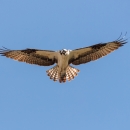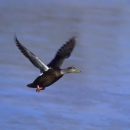Seasons of Wildlife
Wildlife on Martin NWR changes with the seasons. During the fall and winter, the secluded marshes, submerged aquatic vegetation (SAV) and abundant food provide excellent habitat for migratory waterfowl. The widgeon and eel grasses are a high-energy food source utilized by waterfowl to maintain their muscles during migration. Aerial winter surveys have shown nearly 10,000 ducks, geese, and swans utilizing Smith Island. Common species include redhead, bufflehead, green-winged teal, surf scoter, and black duck, as well as Canada geese and tundra swans. The protection of this habitat is especially important for black ducks, whose numbers continue to decline due to degraded aquatic environments destruction of important breeding areas, and human disturbance. Black ducks can be seen at Martin NWR throughout the year, using the refuge of both feeding and resting grounds.
During the spring and summer, the salt marsh salt marsh
Salt marshes are found in tidal areas near the coast, where freshwater mixes with saltwater.
Learn more about salt marsh grasses, SAV, and abundant invertebrates provide food and cover for various nesting species. Gulls, oystercatchers, and willets nest and feed along the marsh grasses, mud flats and sand bars. Many other bird species such as clapper rail, seaside sparrow, and marsh wren also depend on the habitat the refuge protects. The SAV beds serve as a nursery ground for many species of fish, crustaceans, and mollusks including the iconic blue crab.
The wooded ridges of Smith Island and Watts Island provide nest sites for yet another group of birds, the waders. Wading birds prefer to nest in colonies or groups known as rookeries. Nine different species, including glossy ibis, little blue heron, tricolored heron, great egret, snowy egret, cattle egret, and yellow- and black-crowned night-herons, have been seen in rookeries on the refuge. Ospreys are by far the most abundant bird-of-prey on the refuge. They can be seen March through September hunting for fish in the waters around Smith Island, often utilizing buoys, towers, boat lifts and other manmade structures as nesting platforms. Two recovered endangered species, the bald eagle and the peregrine falcon, are also common to the refuge.
The habitats of the refuge support an assortment of other species of wildlife. Periodically, endangered leatherback sea turtles and threatened loggerhead sea turtles surface in the surrounding estuary. Small populations of red fox, muskrat, mink, otter, voles, and non-venomous water snakes inhabit the refuge. The northern diamondback terrapin, a turtle that lives exclusively in brackish water, is commonly seen in the waters around the refuge. The terrapins use the soft soils of the marshes and upland areas to lay their eggs in spring and summer.
Featured Species
The tidal marsh, coves, creeks and ridges of Martin National Wildlife Refuge provide an important rest area and winter home for thousands of migratory waterfowl and nesting habitat for a variety of wildlife that change with the seasons.





